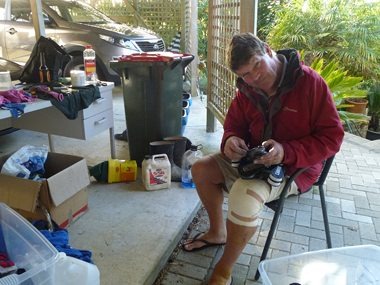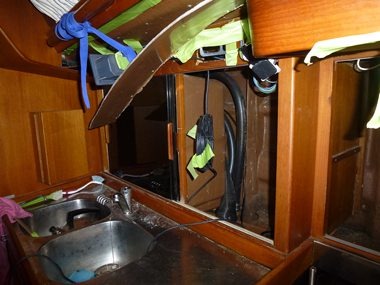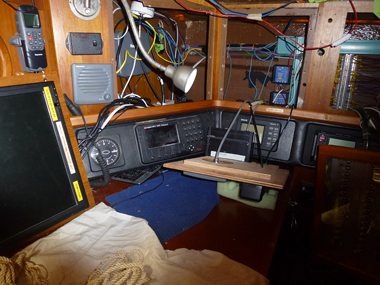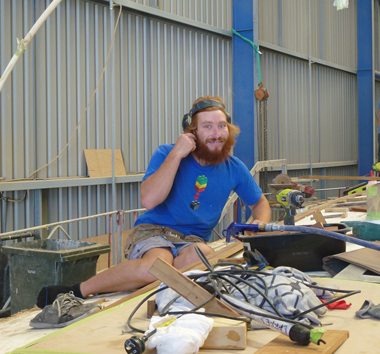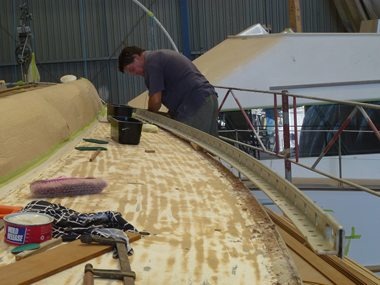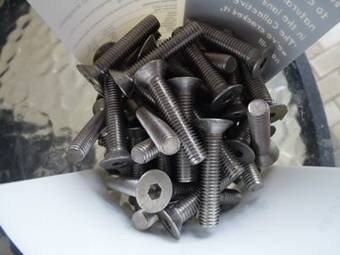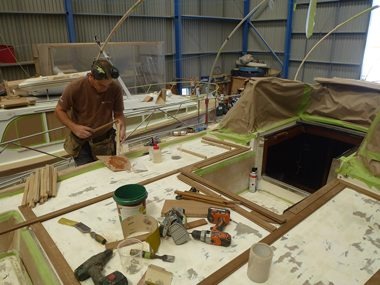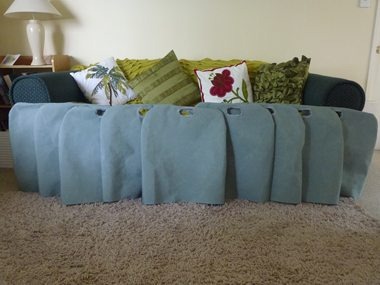Friday 14th March – Knees and Dicks

|
Friday 14th March – Knees and Dicks.
Knees first. Jon had keyhole surgery operation on his left knee to remove various lumps of cartilage that were responsible for locking it in position and making him behave as though he was middle-aged or worse. That appears to have worked well. It was an hour or so under general anaesthetic and then off home to get on with as much walking/clambering/cycling as he could manage. Cycling is much loved by knee surgeons and with that in mind, we had already bought a fabulously expensive Chinese-made mountain bike (18 gears, knobbly tyres, made of recycled railway tracks and complete with extra-dirt-cheap components, get-U-started rust and wheels that needed truing) which cost NZ$88 (that’s almost £45!) brand new but on special offer from The Warehouse (an NZ shop/store) in Whangarei. The compulsory cycle helmet (Oh, per. . lease!) cost almost as much. Technologically speaking, the bike is a touch basic (one could go further but this is a family show). However, the wheels go round and the brakes and gears more or less work. And, we’d still be ‘quids-in’ if we’d paid three times as much for it. The distance from our flat to the Brin Wilson Boats’ ‘shid’ in Gulf Harbour marina is a mere 4km or so. But, the road is like a roller-coaster. Whichever way you cycle there is a quite a lot of uphill work. Notwithstanding that, given that our flat is at the top of a hill and the marina is (oddly enough) at sea level it’s net downhill for Jon on the way to ‘work’ and net uphill on the way home. By some margin. But, it has to be said that the surgeons appear to be right – cycling is magic stuff for knees and wasted thigh muscles (because you’ve been nursing the ‘bad’ leg) after such operations.
Jon back at work in his outdoor shed at the flat the day after his operation.
Of course, this cycling stuff is helped by the fact that it is still summer here and that we are about as close to the Equator as is the south coast of the Algarve, in southern Portugal. Autumn starts on the 21st of this month (I think, taking account of the NZ 13 hour lead on GMT) when the sun re-crosses the Equator, heading north. Just as England awakes to bask in the warmth and the sunshine of the first day of spring. Or, not.
So, what of progress on Arnamentia? Quite a lot really. Even before the guys had started planing and grinding the old teak off the deck (the last post will have educated you sufficiently to know that in Kiwi-speak this is a ‘dick’ – hence the title of this post) they had, obviously, removed the genoa and staysail tracks. These four tracks are each about 5m (16 feet or so) long aluminium T bar strips which are through-bolted to the deck with stainless steel bolts and bonded to it with adhesive sealant (our old friend M3 5200 - “When I say ‘permanent’ I mean ‘permanent’). Of course, in salt water, aluminium in contact with stainless steel will inevitably corrode unless serious measures are taken to prevent that happening. Even assuming that such measures have been taken (choose your poison; Tefgel, Duralac, Lanacote, plastic barrier washers - whatever) nothing is going to last 24 years. This is particularly so if you are going to be reckless enough to take your boat to sea and get it covered in salt water. Once the water evaporates it leaves a layer of salt which happily bridges the anti-corrosion layer between the different metals. So, it is pretty useful to wash the boat down in fresh water after every use. But, that isn’t easy if you don’t spend your life in a marina.
Anyway, it didn’t take long to decide that, whilst these tracks were off, they might as well be sent away for re-anodizing. In the overall scheme of things this is not an expensive operation. What may be expensive (unless you do it yourself) is the detailed cleaning up of the items before despatch for anodizing. Every speck of old adhesive sealant has to be removed. In our case that included (amongst plenty of other things) every speck in each of the 220 bolt holes in the rails. So, that kept Jon out of mischief for a few days. He eventually had to use an electric engraving tool to dig out all the rubbish in the bolt holes.
It was now impossible to ignore the fact that the aluminium toe rail was suffering from the same problem. There was evidence of corrosion at the sites of many of the bolts holding it to the deck and the various stainless steel stanchion bases and pulpit/pushpin feet mounted to it. And, we were going to team a pristine teak deck with dog-eared toe rail? Er, no. So, that was also destined for re-anodizing. It was also clear that if you have a teak deck and ever want to remove the toe rail there is really only one time you should attempt to do it. That’s when the teak deck has been removed. Otherwise you haven’t a prayer of getting under the rail to lever it off without seriously damaging your teak because, no matter what thickness it is, the bottom of your toe rail lies on the same underlying surface as the bottom of your teak and is butted up firmly to it.
So, the iron was hot and we needed to strike. Yes, well. Brin Wilson Boats gave us a perfectly reasonable price for taking the toe rail off and re-mounting it after we’d cleaned it and had it re-anodized. It would have amounted to something like NZ$12,000 or £6,000. Alternatively, we could do it ourselves. The issue here is that it really is not skilled work but Brin Wilson do not employ a ‘bench’ of unskilled workers who can be hired out at labouring rates to do grunty jobs. So, the answer was, obviously, that we’d do it.
My mind is drawn back to 1970 when I accompanied one Andrew Corbet-Burcher to the Gieves and Hawkes branch in Camberley just as we were about to be commissioned into the Royal Artillery from Sandhurst. He had with him his Sandhurst No 1 Dress (‘Blues’) uniform jacket and wished these Saville Row tailors (who had built the rest of his uniform) to remove the Sandhurst buttons and collar dogs and replace them with Royal Artillery ones. He was quoted the outrageous price of £5 – which in 1970 was a substantial sum. It was about 10% more than the daily rate of pay of a newly commissioned 2/Lt and Andrew’s entire mess dress uniform (the most expensive item of uniform we were required to buy) had cost £80 from the same tailor. His exclamation that any competent seamstress could do the job for a tiny fraction of that price was met with a frosty sort of look from the cove manning the shop and a (perhaps entirely justifiable) repost along the lines of “That may indeed be so, Sir, but we do not employ seamstresses”. Andrew’s unmodified (and possibly a little disconsolate) jacket accompanied us upon our departure.
Anyway, back to the toe rail. This is a very substantial ‘L’ section length of aluminium surrounding the entire deck. It and the various stanchion bases, fairleads and the like are held on with precisely 436 (that’s four hundred and thirty six) bolts, penny washers and nuts bolted through the deck. When the boys in Finland built the boat they inserted the major bulkheads and then put on the deck. Then they bolted the toe rail on. Then they let loose the guys who put on the teak deck and others who do all the internal carpentry and glass in the fridge, other galley compartments, cockpit lockers and so on. The upshot is that getting to all the nuts was, as they say in these parts, a major mission (or, just a ’major’). It required the wholesale disassembly of lockers and, because the lad who finished off the inside of the hull or installed the various fibreglass cabinets thought it a good idea, a fair number of these nuts were encased in fibreglass. So, getting a spanner to these required earlier addressing with a chisel and hammer – usually whilst lying in some impossible to replicate position and wearing a head torch. In some cases it was necessary to cut holes in bulkheads or the backs of lockers and behind the fridge and so on to gain access at all. Notwithstanding that, in some cases the only thing that would persuade bolts to come out was serious heating with a blowtorch. Let’s not beat about the bush here – it was piggin’ difficult. As was communication, with Carol generally below decks and Jon above in a very noisy workshop. However, we got it done over a period of several days with the assistance of the excellent apprentice, Michael, for a few hours when only a skilled (9 years experience so don’t let the ‘apprentice’ bit fool you), nimble, slim, lithe, flexible young whipper-snapper of a contortionist was going to be able to achieve what was required.
Carol spent quite some time sitting with her feet in the sink and her top half bent around the back of the locker sharing a small space with all those hoses.
All instruments panels removed to get access to those pesky bolts
Michael happy to be out of the small spaces which Carol couldn’t get into
That was the worst of it. However, now came the issue of detaching the thing from the deck. As ever, industrial quantities of our old friend M3 5200 had been used to bed and glue the rail to the deck. Getting the toe rail off took Jon another two days with a serious sort of hammer, lots of hardwood wedges, a very sturdy stripping knife (two, in fact, because after much valiant service doing a job it was not designed to do, the first eventually expired and could not be resuscitated) and an electric paint stripper (one of those things that looks like a hair drier but don’t try this at home) to soften up the adhesive under the rail. The difficulty, of course, is getting it off by being pretty violent but without damaging either the boat or the rail. Or, setting fire to anything. But, all was achieved in the end.
The last section of toe rail now nearly off
Having had his left knee fixed Jon now has a bit of an issue with his right shoulder as a result of hammering away for something like 18 hours with afore-mentioned bl**dy big hammer. We hope it passes.
What remains now is to clean up all the elements of the toe rail (including the 436 bolt holes), get it all off to the anodizer, clean off all the M3 5200 left on the deck underneath where it sits, re-bed and refit it and rebuild the interior of the boat. So, one or two things really. Amongst other delights, Carol has the enviable task of sitting outside the flat and cleaning up all the bolts with a wire brush and using a 50/50 mixture of Toluene and Acetone – lovely stuff as you can imagine, but it does make life a little easier.
Before – mucky M3 5200 coated bolts Bright and shiny after wire brush treatment
Carol’s outdoor airy shed – vital for fume dispersion
Meanwhile, it has been a huge pleasure to observe the skill and attention to detail being demonstrated, by both Terry (the lead) and Michael in re-decking Arnamentia. For instance, no boat – not even a Swan – is precisely symmetrical. Terry knows full well that it is his job to make asymmetry disappear from view and to accompany that achievement with exquisite workmanship. Watching him do it is a real education.
Arnamentia’s deck stripped bare on 4th March
Terry laying the first of the teak strips
Nine days later the small cockpit and bridge deck very nearly finished
Carol has also been very busy making covers for our nine jerry cans (6 diesel, 3 petrol) which sit on the side rails. The first we bought in Panama sustained severe UV damage whilst we crossed the Pacific. Having a large table for the sewing machine and room to lay out the Sunbrella material in the flat made the job a lot easier. They may not be haute couture but they should do the job.
Nine jerry can covers on parade in the Manly flat sitting room
Our tentative plan now is to get the toe rail and relevant bits of the deck cleaned up. Then leg it back to the UK for about a month, whilst the new teak deck is completed, before we come back to reassemble the boat, do all the other stuff that needs doing and think about heading north again to Fiji.
All of which is why this sort of cruising is not an extended holiday. It’s a way of life. |
